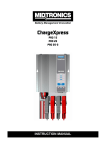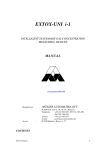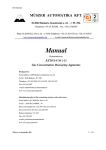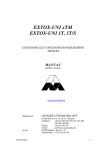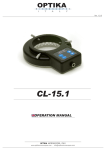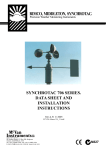Download GAS RAPTOR controller user manual
Transcript
GAS-RAPTOR STATIONARY GAS CONCENTRATION-MEASURING APPARATUS MANUAL Műszer Automatika Kft. Headquarters: Postal address: H- 2040 Budaörs, Komáromi utca 22. Hungary P.O.B: H-2040 Budaörs, Pf.: 296 Telephone: (00 36 23) 365-280, (23) 414-922, (23) 414-923 Fax:, (00 36 23) 365-087 e-mail: [email protected] web: www.muszerautomatika.hu Gas Detector Manufacturing, Sales and Service: Postal address: H-2030 Érd, Alsó u. 10. P.O.B.: H-2030 Érd, .P.O.B.: 56 Sales and Manufacturing: (36 23) 365-152, (23) 524-152 Service: (00 36 23) 416-761, (23) 428-761 Railway telephone: 01-5211 Fax: (00 36 23) 365-837 e-mail: [email protected] web: www.gazerzekelo.hu 1 CONTENTS 1. PURPOSE 2. MOST IMPORTANT FEATURES 3. CONSTRUCTION 4. OPERATION 4.1. 4.2. 5. Operation of remote transmitters Operation of central unit INSTALLATION 5.1. 5.2. 5.3. Conditions Placement of of remote transmitter and central unit Cabling 6. COMMISSIONING 7. HANDLING AND OPERATING INSTRUCTIONS 7.1. 7.2. 7.3. 7.4. 8. CONDITIONS OF SAFE OPERATION 8.1. 8.2. 8.3. 9. Handling units Connecting points Operation, handling, interpretation of status signals Cleaning Safe operation Contact protection aspects Meaning of markings on the apparatus TECHNICAL DATA 9.1. 9.2. Central unit Remote transmitter 10. GUARANTEE 11. SERVICE, MAINTENANCE 12. APPENDIX 2 1. PURPOSE Gas concentration measurement, danger signalling and intervention control by operating of gas concentration measuring remote transmitters of 4…20-mA. 2. MOST IMPORTATN FEATURES → Stationary construction for industrial use → Operating possibility of 12pcs of remote trasnsmitters → Computer configurated signal processing by processors, → Programmable 2 signal levels + acknowledgable acoustic signal + self- error signal → Acoustic signal control may be assigned to any signalling level → Possibility of manually operated venting system → Venting system preprogrammable for times and duration of time → Programmable fan postrotating time → Operation of dual- phase fans → Intervention cotrol separable by zones → Relay contacts are programmable for different intervention control purposes → Event logging → Signalling of maintenace claim → Signallimg of network power cut in case of uninterrupted operation → Putting into operation and maintenance are by means of computer, during which several settings can be changed without constructionional modification upon actual application requirements → No need for frequent maintenance 3 3. CONSTRUCTION The apparatus consists of central unit and remote transmiters (1-12 pcs) the type and quantity of which is determined by the application. The central unit is an electric control cabinet that includes the control system of the apparatus. It is suitable for a accepting any cables for proper application (with which for example acoustic horn and danger signalling alarms can operate) and it has a simple handling units for its operation. The cabinet can be opened by a key and its inner configuration can be surveyed easily. The remote transmitters are smaller cases in which the gas measuring sensors and measuring electronics are located. The technical solutions of remote transmitters ensure the easy insertion of gaseous materials to be detected to the sensor. The remote transmitters are suitable for direct mounting of the cables which lead to the central unit. 4. OPERATION 4.1. Operation of remote transmitters Sensors convert the gas concentration into electric signals in the transmitters. The electric signals of sensors are processed by the electronics. The electronics receive the power supply from the centre and the concentration is forwarded to the central unit by an electric current signal in the range of 4...20mA. 4.2. Operation of central unit It measures the current consumption of transmitters and evaluates the measurement results. It controls relay contacts on the basis of evaluation i.e. depending on danger level of concentration, for example it controls the venting system, the danger alarm lamps, and acoustic signalling horn. It gives signals verifying its own operation and the danger level of measured concentration. The control of venting system is based not only on the danger level of concentration. Not depending on the measured concentration it is possible to operate the venting system according to time program and duration of time by preprogrammed way or even manually. The apparatus is also suitable for operation of several intervention systems separated by zones. It is solved, in this case, by using more relays than in basic construction and by arbitrary logical distribution of remote transmitters. In basic construction there are 4 pcs of relays built-in for the the control, in the following way: -Self-error relay (ÖH); its goal is to remote check its operability -Presignal relay (E1); its goal is the intervention control -Alarm relay;(R1); its goal is the intervention control 4 -Acoustic relay (H); acknowledgable, its goal is the operation of acoustic horn Relay operation in the function of operating states in case of basic construction Operating state Without power supply For 1 minute after switching on not depending on concentration Below K. E level Between K. E and R level Above K. R level Self error Uninterrupted operation Relay state E1 Basic state R1 Basic state ÖH Basic state H Basic state Basic state Basic state pulls Basic statet alaphelyzet pulls alaphelyzet Basic state t pulls pulls Basic state * pulls X pulls X ** *** X X pulls Basic state alaphelyzet It swiches over and over again in regular interval **** E........ presignal R........ alarm K........ concentration *.........it pulls if it is assigned to presignal **........ it pulls if it is assigned to alarm ***...... it pulls if it is assigned to self error ****... it operates in the same way as if it were not in uninterrupted operation X......... in accordance with measured carbon monoxide concentration if the apparatus is operable together with at least one transmitter The operation of preprogrammed or manual venting system can only have effect on operation of its purposefully installed relay (in basic construction this is relay R1). In case of dangerous concentration the manual switch off of the venting system is impossible by the handling units of the apparatus. The presignal, the alarm and acoustic relays get into basic position automatically after elimination of concentration that generated their pulling concentration in basic configuration . The acoustic signalling relay may be switched off even before aotomatic switch off. There are LED status signals inside the apparatus to trace the relay operations. 5 5. INSTALLATION 5.1. Conditions The apparatus is allowed to be installed in such places the requirements of which meet the technical parameters of the apparatus. It is not alowed to expose it to extra high or low temperatures or radiating heat. Those places should be avoided where water dripping may occur. The installation site should be selected in a way that the possibility of works of putting into operation, regular maintenance, the proper and safe operation of the equipment is ensured. 5.2. Placement of remote transmitter and central unit Usually a design documentation specifies the placement of remote transmitters and central unit. In the lack of it the placing shall be made with care. During placement of remote transmitters the prescriptions of individual manuals of remote transmitters shall be observed, also the relative density of measured material relevant to air, and the most possible outflowing places of measured material shall be taken account. The detector head of remote transmitters must always be mounted in direction downward. Durind placing of central unit the features of the establishment, the cable routes and the location of connecting electric devices shall be taken account (for example control cabinet of intervention system) Such place shall be selected where rational and cost effective cabling is possible. For example if the venting system has to be be controlled manually as well we have to take into accout the prevention of unauthorized accessibility. The central unit is suitable for mounting on vertical surface. 6 5.3. Cabling During cabling of remote transmitters the following should be observed: • The transmitters shall be connected to the central unit in radial configuration. Each transmitter shall be connected to the central unit separately by one at least two-wired shielded cable. • The diameter and wire diameter of transmitter cable must be the same as specified in the transmitter manual. • The loop resistance of transmitter cable must be lower than the limit specified in transmitter manual. • The cables shall be identifyable for identification of location in the establishment • During cutting to length of cables excess length must be left for mounting During cabling of central unit the following must be observed: To connect the central unit any types of cables specified in installation booklet or identical with them must be used • All the cables except transmitter cables are connected to the equipment at the top. • The transmitter cables coming from the upper part shall be placed side by side and directed to the lower side of central unit by spacer between the wall and the apparatus • 6. COMMISSIONING The precondition of commissioning is the existence of the apparatus suitably installed according to Chapter 5 and existing network power voltage. Commissioning means connecting, switching on and on-site checking of proper operation of the apparatus. The commissioning is carried out by the manufacturer or service company contracted with the manufacturer at the customer’s cost. If the manufacturer supplied the equipment together with ordered accessories (damage signalling lamp, acoustic horn) the commissioning also covers them. The putting into operation is made by computer based diagnostic program. During putting into operation certain operating settings can be changed if the requirements at the time of order have been changed since then. A commissioning protocol is made about the putting into operation by means of the diagnostic program which shall be legalized by signature of commissioning person, the customer or his/her authorized representative(s). 7 The commissioning protocol includes the main settings of the apparatus, including the detailed information on preprogrammed and manual operation of venting system. Even in case the devices to be operated by the apparatus (for example the intervention system, venting system, building surveillance) have not been put into operation by the date of commissioning, the apparatus can be put into operation. In any case it is worth putting it into operation in that period when the complete system can be tested in order to avoid random operational disturbancies. If the conditions of commissioning are not ensured by the customer by the agreed time the comissionig fails at the risk of customer. In this case the cost of failed commissioning is covered by the customer. Attention! The apparatus cannot be put into operation withou using the diagnostic program necessary to commissioning and maintenance. The apparatus switched on without using of diagnostic program is suitable for operation but it gives continuous self-error signal and it also it warns with periodical short acoustic signal. 7. HANDLING, OPERATING INSTRUCTION 7.1. Handling units The apparatus has the following handling units in its construction • • • • • • • basic Alarm lamp {red}, Presignal lamp {yellow}, Acknowledgement button, Operation lamp {green}, Diagnostic connector, Network fuse Acoustic output fuse The diagnostic connector, the network fuse and the acoustic output fuse are located in the inner part of the apparatus. In the inside there are further LED-type status signals for tracing of relay operations and checking its operation but these are not handling units . 8 7.2. Connecting points The build-up can vary according to the need of the order. Therefore the exact information is contained in the wiring booklet of the apparatus. The connection points according to the basic build-up are as follows: Mains voltage connection points with series terminals 1 2 3 4 5 8 Mains power supply, earth protective conductor Danger-warning light earth protective conductor Mains power supply and danger-warning light zero conductor Acoustic alarm horn zero conductor Mains power supply, phase conductor Acoustic alarm horn phase conductor E1, ÖH relay outputs 11 12 14 21 22 24 Morse contact 1 Break contact 1 Locking contact 1 Morse contact 2 Beak contact 2 Locking contact 2 R1 relay output 21 12 14 Morse contact, danger-warning light phase conductor Break contact Locking contact The connection points of transmitters on the control panel +1+2+3+4+5+6+7+8+9+10+11+12- Connection points of the transmitter no 1, positive and negative poles Connection points of the transmitter no 2, positive and negative poles Connection points of the transmitter no 3, positive and negative poles Connection points of the transmitter no 4, positive and negative poles Connection points of the transmitter no 5, positive and negative poles Connection points of the transmitter no 6, positive and negative poles Connection points of the transmitter no 7, positive and negative poles Connection points of the transmitter no 8, positive and negative poles Connection points of the transmitter no 9, positive and negative poles Connection points of the transmitter no 10, positive and negative poles Connection points of the transmitter no 11, positive and negative poles Connection points of the transmitter no 12, positive and negative poles CS1 Mains connection socket (only for service purpose, it is not needed for the proper use!) 9 7.3. Operation, handling, interpretation of status signals The apparatus can be operated according to the programmed function. The minutes prepared by means of the diagnostics program describes the programmed function. The apparatus can be operated in part automatically; can require in part manual handling according to the programmed function as follows: Event or task Handling Because of the increase of the gas concentration a signalling level switches on (warning signal, or alarm signal too) Because of the decrease of the gas concentration the signal level is switched off (alarm signal, or warning signal too) Because of the switch-on of the Press the acknowledging button warning-signal or alarm-signal level the acoustic alarm horn gives sound; the handling person took notice of its reason and wants to switch off the horn The handling person wants to Press the acknowledging button switch on the ventilation system The acoustic alarm horn gives no sound) The handling person wants to Press the acknowledging button switch off the ventilation system (the ventilation system operates, the acoustic alarm horn gives no sound) The handling person wants to Press the acknowledging button switch on the ventilation control and keep it pressed continuously pre-programmed according to the until the alarm signal flashes times and periods (the acoustic twice (red) alarm horn gives no sound) The handling person wants to Press the acknowledging button switch off the ventilation control and keep it pressed continuously pre-programmed according to the until the warning signal flashes times and periods (the acoustic twice (yellow) alarm horn gives no sound) 10 The ventilation can be operated by means of manual control only when it is permitted according to the programming. If the ventilation control pre-programmed according to times and periods is permitted and switched on, then the ventilation system can operate with a weekly system on any day of the week, in any quarter of hour. In this case the ventilation system will operate according to the programming, i. e. at the pouring over the dangerous material to be detected regularly according to plan, when otherwise the gas concentration does not justify it. Interpretation of the signals: Signals Operation signal (green) is lighting Operation signal (green) is not lighting Interpretation of signals The apparatus is operating, there is no self-error signal There is a self-error signal from the following possible reasons: - the apparatus does not receive power supply - it has not been put into operation according to the regulation - it is not maintained - it failed in part or totally Neither the warning signal The gas concentration is lower than (yellow) nor the alarm signal the programmed warning-signal level (red) is lighting The warning signal is The gas concentration near at least lighting (yellow) one remote transmitter exceeds the warning-signal level, but it does not reach the alarm-signal level (There is gas danger) The warning signal (yellow) The gas concentration near at least and the alarm signal (red) one remote transmitter exceeds the are lighting alarm-signal level too (There is increased gas danger) Operation signal (green) The apparatus does not receive mains flashes in regular time voltage, but t is still operating from the uninterrupted power-supply unit Remark: Switching on the signalling levels can be done also to decreasing levels, for example, at the measurements of oxygen concentrations. 11 When the operation lamp is not lighting in spite of the performance of the prescribed maintenance and it is not caused by the lack of the power supply, so it means any kind of failure. Already the inoperability of one remote transmitter also results in a self-error status. In the self-error state one part of the apparatus operating with more transmitters still can perform its proper task, therefore, the warning signal appearing at the same time with the self-error state, or the alarm signal must be considered a real gas danger. If the apparatus failed, so the repair must be requested. During operation the apparatus logs the events. If the user needs the data recorded in the event log, then he can get access to them, through the manufacturer or his contracted partners. Reading and printing out the event log is performed by means of the computer diagnostics program. 7.4. Cleaning The central unit and transmitters can be cleaned according to need. On cleaning the ingress of the water or other cleaning agent into the inner part of the apparatus must be prevented. Fort he cleaning only such material and tools may be used, which do not damage the apparatus and make the inscriptions unreadable. The detecting head on the transmitter must be protected particularly from the ingress of the water and other cleaning agents. The cleaning of the remote transmitter The cleaning of the transmitter dirty in inhibitive measure is the task of the technician performing the maintenance. 12 8. CONDITIONS OF SAFE OPERATION 8.1. Safe operation The power supply must be protected with a cutout or a fuse. To the apparatus may be connected only such electric devices, which are needed for the proper use and do not cause exceeding the limit values given in the technical data. The self-error contact of the apparatus must be used for the remote check of the operation (i.e. connected to the building-supervision system). If there is nothing, to which this contact can be connected, so the handling staff can know only from the lack of the operation signal that the apparatus cannot perform its proper task (i.e. in lack of power supply or failure). It is forbidden to make any modification in the apparatus without the approval of the manufacturer! 8.2. Contact protection aspects The apparatus is an electric device of the contact protection class I, which is operating from mains power supply of 230V. To the connection point established for this purpose a earth protective conductor must be connected by all means. The zero and phase conductors of the mains power supply must be connected according to the connection booklet. Under voltage the door of the apparatus must be kept closed for incompetent persons the touch of the inner parts of the apparatus is forbidden and means life danger. In the apparatus there are circuits of different voltage level, separated from each other by means of an reinforced insulation. The cabling must be performed so that the insulation between the circuits of different voltage level cannot be damaged. It is forbidden to connect the contacts of the relays located in the apparatus, with two contacts to circuits of different voltage level (i. e. 5V and 230V). 8.3. Meaning of markings on the apparatus Earth protective conductor connection point Attention! {See the documentation!} B1 Mains fuse B2 Acoustic alarm horn fuse CS1 Mains connection socket 13 9. TECHNICAL DATA 9.1. Central unit The following technical data concern the basic build-up of the device! Type: GAS-RAPTOR Maximal number of the remote transmitters: 12 pieces Power supply: 210...242V 50Hz, max. 25VA Overcurrent protection necessary for the power supply without external consumers: 2A Contract protection class: I Mains fuse B1: 630mAT Acoustic alarm horn fuse B2: 1AT Protection (MSZ EN 60529): IP54 Pre-signalling level: 10% of the measuring range Alarm level: 20% of the measuring range Relay contacts: Marking of the relay Number of contacts Use generally ÖH E1 R1 H 2 pieces 2 pieces 1 piece 2 pieces Remote control of the operation Operation of the ventilating system Operation of the acoustic alarm Type Voltage-free Voltage-free s Loadability 250V AC 5A, or 30V DC 5A 250V AC 5A, or 30V DC 5A Operation of the dangerwarning light Gives the mains voltage According to remark no. 1 Cable lead-in possibilities for the emote transmitters: Cable lead-in possibilities for the acoustic alarm horn: the mains power supply, for the danger-warning lights and ventilator control: Ambient temperature: Dimensions: Mass: According to remark no. 2 According to remark no. 2 12 pieces of PG9 stuffing-boxes 1 piece of PG9 stuffing-box 7 pieces of PG11 stuffing-boxes 0...40oC 469 x 300 x 171 mm ca. 5kg 14 Remarks: 1. At the parallel compensated light tube with traditional ballast max. 4A (6 pieces of 2x36W light fittings). At uncompensated light tube with traditional ballast max. 6A (9 pieces of 2x36W light fittings). At the bulbs max. 9A (1800W). 2. One of the contacts is under voltage. Its loadability is 1A. Onto the output established for this purpose (acoustic alarm horn phase conductor and acoustic alarm horn zero conductor) gives out the mains voltage. The second contact is no-voltage, its loadability is 250V AC 5A 1250VA. 3. At the no-voltage contacts the locking, Morse and break contacts are also used. The contacts of the relays with markings ÖH, E1and is prohibited to use for the operation of the light-tube light fittings! 9.2. Remote transmitter The technical data of the transmitters are found in the relevant separate manuals. 15 10. GUARANTEE The Műszer Automatika Kft undertakes a guarantee for 3 years reckoned from its putting into operation for the GAS-RAPTOR type device with the exception of the remote transmitter, in case of proper use. The condition of the guarantee is the absolute observation of the regulations for the installation, putting into operation, handling, safe use and regular maintenance. Attention! The switch-on and operation of the device without using a diagnostic program is not considered commissioning and it involves loss of the guarantee. The guarantee concerns only faults of origin of manufacture. It does not cover damages occurred during the transport, storage, installation or use, or those originated from not having observed the regulations of the manual. 11. SERVICE, MAINTENANCE The apparatus is a safety device that must be maintained regularly in the interest of the long-term operation. Even in case of a fault-free operation the maintenance must be performed at least once yearly. For the guaranty period and thereafter as well, a maintenance contract can be concluded with the manufacturer or his contracted partners in the interest of the continuous maintenance. The maintenance is made by means of a computer diagnostics program. The maintenance means surveying the general technical state, checking the proper operation of the apparatus, making the settings more precise, as well as, in case of need, the trouble shooting. During the maintenance there is also possibility to modify certain settings according to request. The maintenance is carried out by the manufacturer or service contracted with the manufacturer, against payment. Attention! The apparatus cannot be maintained without using the computer diagnostics program necessary for the commissioning and maintenance. If the maintenance is late by more than one month as compared to the due date, although the apparatus will be operating further, but generate a continuous self-error signal and short periodic acoustic signal. Repairing the malfunctions occurred during the operation of the apparatus can be performed also besides regular maintenances. The trouble shooting must be requested at the manufacturer or its contracted partner (at which the maintenance contract has been concluded). The following must be announced: - place of installation, - name of the establishment where the device is located, - manufacturing number, - feature of failure, - name and accessibility of the contact person of the operator. 16

















